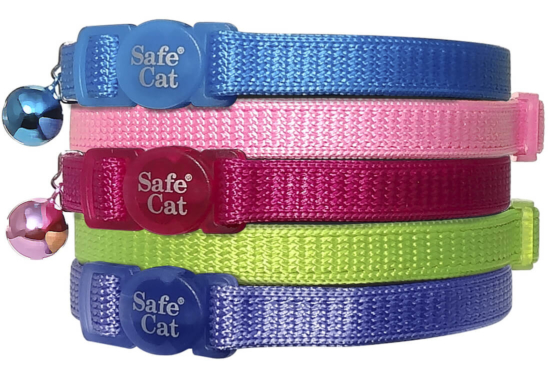Should my cat wear a collar?
Definitely! But not just any collar. It needs to be safe (see below) and have visible ID. Proper identification greatly increases the chances of your cat being returned to you. Our personalised cat collars make it easy for you to be contacted because your phone number is printed big and bold directly on the collar. It’s a great alternative to a cat tag which can get caught on things and which some cats find annoying. We offer two types, Personalised Soft and Personalised Reflective.
What is the safest cat collar?
The safest cat collar has a quick release clasp and doesn’t stretch. There are many hanging hazards both inside and outside the home, so this is the only type of cat collar to consider.
The quick release clasp opens quickly if your cat gets caught on something, preventing strangulation.
The collar should not stretch. Elasticated cat collars (with an elastic insert or fully elasticated) – even if combined with a quick release clasp – are not safe. A cat can get its front leg caught in the collar, which can cause a serious injury. Even with veterinary treatment, sometimes the injury doesn’t heal and may require amputation. Another scenario is if the cat gets caught on something, it will struggle, twisting and twisting the elastic. This may lead to strangulation. With one of our quick release cat collars, the collar would quickly release and free the cat from danger.
My cat is microchipped. Does he need a collar?
Yes! The problem with relying on microchipping alone is that many people assume that a collarless cat is homeless, start feeding it, the cat doesn’t leave, and they end up adopting it. Meanwhile, the cat’s owner is heartbroken because they’ve lost their beloved cat.
Because we sponsor Cat Chat, we get many calls from people thinking we’re a rescue, wanting to find a home for a “stray” they adopted years ago. I ask if they’ve had the cat scanned for a microchip and they usually say “what’s that?”.
A woman called to order a collar for a cat that had appeared in her garden several years before. I asked if she had ever had the cat scanned for a chip and she hadn’t, despite her own cats being chipped.
Also, the person who finds a cat may not have a cat carrier or transport to be able to take the cat to a vet. A man called us about a cat in his garden. I asked him to take it to a vet to be scanned for a chip. He asked if it would be OK to wrap it in a towel and take it on a bus! Needless to say, I said no, and recommended he ask someone to loan him a cat carrier and give him a lift to a vet.
We recommend a microchip plus one of our personalised cat collars with your phone number printed on the collar. We offer two types, Personalised Soft and Personalised Reflective.
My cat never leaves our garden. Does she need a personalised cat collar?
Absolutely! Your cat could get chased out of her familiar territory by another animal or scared by fireworks and get very lost. Many cats find an open car or van simply irresistible. We keep hearing about cats that have hitched a ride and ended up many miles from home. So it’s very important that she wears visible ID.
Should my indoor cat wear a collar?
Yes! Indoor cats need collars with ID too! An indoor cat that escapes from the house is much more likely to become frightened, disoriented and lost, so it’s extremely important that he wears identification. Indoor cats can escape from open doors and windows, and during break-ins. In the case of an emergency such as a fire or flood, you and your cat will need to get out quickly, so putting him in a carrier may not be an option.
Do you sell cat safety collars?
We sell quick release cat collars, the only type of cat collar which can genuinely be described as a “cat safety collar”. Unfortunately, some retailers refer to elasticated cat collars as “cat safety collars”, but animal welfare organisations including Cats Protection and RSPCA are very clear that elasticated cat collars are not safe. You only need to search on dangerous cat collars to see the terrible injuries that can be caused by them.










